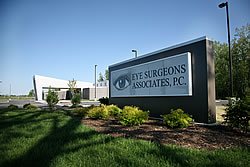 Digital Eye Strain
Digital Eye Strain
By Scott Baldwin, O.D.
One of the hallmarks of life in the 21st century is our dependence on and accessibility to technology, which COVID has increased exponentially. We’re doing everything online – jobs, classes, entertainment, even socializing. Devices are used many hours a day. While technology has been a blessing, it also can have some negative consequences on our eyes.
Computer vision syndrome is not an actual disease, but is a term being used by many groups, the American Optometric Association included, to describe some of the eye and vision problems that are associated with the use of electronic devices. Common computer vision syndrome symptoms are dry eyes, painful eyes, blurred vision, headaches, tired feeling in the eyes, pain in the neck, shoulder, and back and poor sleep. Many of these symptoms can be alleviated. Find out how.
Dry Eyes When we use the phone, computer, or other screen, our blinking becomes severely compromised. We simply do not blink enough and many of our blinks are incomplete. While this obviously makes our eyes drier and more uncomfortable in the short term, there are some long-term consequences as well. Our eyelids contain anywhere from 20-30 very tiny glands that are responsible for producing the oily layer of our natural tear film that keeps our eye healthy and lubricated. These glands can only secrete their oil when we blink frequently and completely. If this is not done regularly, the gland secretions can become thicker and the gland itself can become clogged. Over time, this clogging can permanently destroy the glands and create a lifetime of dry eye issues. Treatments for dry eye-related concerns include artificial tears, warm compresses over eyelids, eyelid massage, omega-3 supplements or prescription strength eye drops.
Near Vision Strain Our eyes are primarily designed to function looking at things far away from us. In order to see things up close (like when we look at a phone or computer), our eyes have to exert effort to see them clearly. While there are many factors that contribute to how well or how long we can hold our eyes in the near vision position, few people, regardless of age or vision status, can hold that position indefinitely. When we overuse our near vision, we can acquire symptoms of headaches, tired feeling in the eyes, difficulty transitioning from near vision to distance vision and blurry vision from either far away or up close. It is important to note that near vision strain is found in middle age, college and high school students and even some elementary-age children. Follow the 20-20-20 rule – Every 20 minutes for 20 seconds, take a break and look 20 feet away from the computer. Discuss with an eye care professional what glasses prescription and type of lens (i.e. anti-fatigue lens, bifocals, progressive lens, computer progressive) you need. Choosing the wrong type of lens, even if the prescription is right, can cause you to have poor posture at the computer and cause neck, shoulder and back pain.
Blue Light Most visible light is harmless to the eye, but some of the higher energy wavelengths, such as blue light, can contribute to eye diseases like cataracts and macular degeneration, cause eye strain and affect our circadian rhythms (body clock.) The sun is the most abundant source of blue light, however a large portion of the light that electronic screens emit falls into the blue light category as well. There is ongoing discussion in the optometric community as to whether or not screens emit enough blue light to significantly contribute to ocular disease. There is a growing consensus blue light contributes to eye strain and alters circadian rhythms enough to cause problems with sleep. Many lens companies have incorporated blue light blocking technology to address concerns common with heavy tech users.
We often underestimate how much technology can affect our vision. Since we know that technology is not going away, do what you can to protect your eyes to enable continued, regular use in the future.
The material contained in this article is for informational purposes only and is not intended to be a substitute for professional medical advice, diagnosis, or treatment. Always seek the advice of your physician or other qualified health care provider.
BIO: Dr. Baldwin is an optometrist with Eye Surgeons Associates. His clinical interests include specialty contact lenses, ocular surface disease management, managing computer vision syndrome, pediatric eye care, and co-management of medical conditions that frequently affect vision. Dr. Baldwin speaks fluent Spanish.




